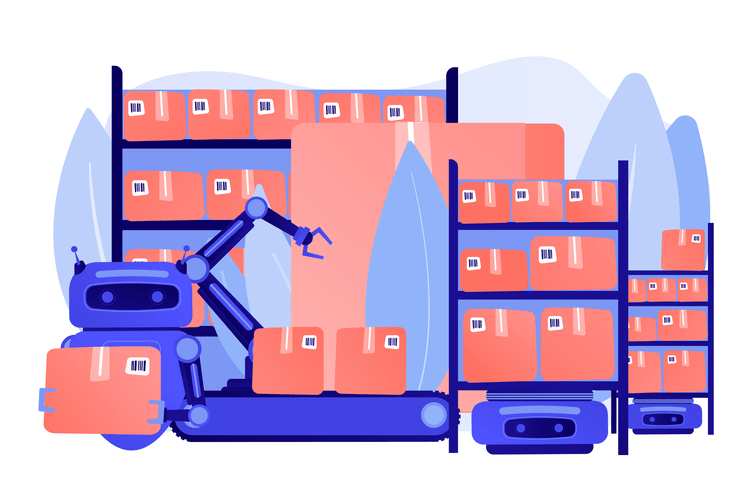Amp up your business’ warehouse optimization game with BinaryFolks’ AI inventory management software. Get real-time updates, reduce management costs, enhance warehouse safety, and much more! Details ahead!
In today’s modern era, vehicles, and manufacturing plants operate autonomously, yet we see the employees carry a pen and paper around stores to record the remaining numbers of remaining products individually. Just to be followed by manually stocking each aisle one by one for literally hours after the stores are closed. These problems however are not as difficult to solve as they may seem at first glance. With the implementation of AI inventory management software, warehouse and store owners could save hundreds of hours worth of labor every year.
Now one may get confused and think that inventory management is just limited to counting remaining products and stocking shelves, but that is far from the truth. Although automating stocking and inventory tracking itself is a pretty big quality-of-life upgrade for retailers, the implementation of AI services like computer vision, machine learning, and deep learning takes it to a whole other level. With the implementation of AI-based inventory software, businesses can make data-backed predictions, ensure product efficiency, ensure warehouse safety, identify rising trends early, and ensure minimal human error just to name a few of the benefits. Let’s discuss them in detail in the next section.
8 Ways an AI Inventory Management Software can Leverage Your Business
Using artificial intelligence in inventory management can help leverage various aspects of inventory optimization to ensure the warehouse’s supply and demand flow is never disrupted.

[1] Demand Forecasting
AI inventory management systems can use machine learning, especially deep learning, to analyze historic business data and market trends to predict an increase in demand for a specific product in a certain part of the year. For example, your retail store has installed an AI model that can give you automated alerts regarding any increase in demand trends. The AI model detects that last year’s data shows an increase in sales of chocolates and candies towards the end of the month of October as families start to stock up for Halloween. It simultaneously scanned the market and found that the wholesale rates of these treats go up from early October as the demand among the other retail owners increases.
AI evaluated both observations and gave you a recommendation towards the end of September to stock up on chocolates so that you can yield the maximum profit when Halloween is around. This is one of the ways in which AI can automatically use the already present data to recommend you business actions that can help you gain a better profit than you normally would.

[2] Avoid Wastage of Products on a Timer
Artificial intelligence for inventory management can help businesses track individual product sales to make sure that perishable products are well-stocked which may lead to an unnecessary loss for your business. For example, you installed an AI model within your wholesale bakery warehouse that distributes various products to the local retail stores. Let’s say the warehouse receives a thousand loaves of white and brown bread every Sunday. And the AI order management runs an inventory check every Friday evening so that any issues can be notified to the manufacturing plant beforehand. One day the AI model observed that the factory still had around 750 loaves of each bread remaining.
The AI model instantly notifies you about the situation and you inform the manufacturing plant to cancel the shipment of this week’s delivery. A single AI model can perform these checks for multiple perishable products in a storage plant. This can help the firm make decisions quickly instead of wasting hours on the problem identification and analysis itself.

[3] AI-Powered Analysis to Lead the New Product Trends
Inventory management software that uses AI technologies like deep learning and NLP can assist you with tracking market trends to gain valuable insights that streamline your efforts towards achieving your business goals. Let’s continue with the last example where the demand for loaves of bread suddenly dropped. You as a store owner want to evaluate the situation in depth, so you used your AI model’s capabilities to do the research for you. The AI model used deep learning to analyze the common keywords that generally link to bread. NLP and web-scraping were then used on the local news articles to find any mention of these keywords.
The keyword “gluten” was found to be used quite often all throughout the last week. Upon further investigation, it was found that the area had multiple health awareness campaigns throughout the weekend. The campaigns tossed the agenda of avoiding gluten-inclusive products like bread, cereals, and others. This affected the sales of white and brown bread. It was also observed that the demand for gluten-free bread increased due to this campaign. So, you asked your manufacturing unit to supply you with an increased amount of gluten-free bread in place of the regular bread shipment.

[4] Automate Inventory Check
Traditional inventory management software has been used for a while now. Regular inventory software is mostly useful to track and archive the sales reports to be referred to in the future. However, this data still has to be manually provided by the employees individually making it even more time-consuming. With the use of AI for inventory management software the entire process can be automated across various industries depending on their specific use cases. For example, a pharmacy in the hospital can keep track of the medical inventory to make sure all the medicines are available at all times for the patients.
AI management software has an advantage over the generic inventory software being used because it can update its data in real-time. Whereas the generic models have to depend on manual inputs. This is possible with the use of technologies like computer vision and machine learning that can track the inventory in real time and notify the machine learning model automatically to update the system for information.

[5] Robots for Warehouse Automation
Gone are the days when robots that assist humans with their regular tasks were only limited to the movies. Industry giants have already been integrating AI inventory management software within their robots to automate warehouse processing. Tasks like stocking, inventory optimization, and other warehouse management activities can be handled by robots in a way more efficient manner than humans. This reduces the operational costs for the warehouse as the efficiency-to-maintenance ratio for the robots is way better than that of a human. But we already know robots can do that, let’s talk about another use case that can greatly benefit businesses.
With bigger warehouse automation chains that use decentralized delivery systems, the robots can be synced with each other across multiple warehouses to ensure a smooth workflow. For example, you have an e-commerce platform that has set up decentralized warehouses within neighboring cities to deliver your products more efficiently. Now one of your warehouses is running low on a specific product because there has been a continuous surge in demand for it.
In addition, you observe that the rate at which products are burning out, the stocks won’t last till the next scheduled delivery from the main manufacturing plant. Fortunately, your AI robots have access to the inventory reports of other nearby warehouses as well. With a short analysis, the robot in the warehouse with the shortage was able to identify a warehouse in the adjacent city with a large stock of the same product with no exclamatory demand for it in that area. So, it briefly notified the situation to the warehouse in the nearby city, and a share of the inventory was delivered to the warehouse with the shortage the very same day.

[6] Enhance Warehouse Safety
We keep hearing about warehouse accidents and hazardous working conditions in many industrial storage units. This might be the case for your employees as well. In case of an accident, people in an authoritative position are held accountable and blamed for the situation. This problem is addressed very reliably by AI management software, with automated maintenance checks and all the heavy-duty tasks being handled by AI-powered robots the working environment for the employees is much safer.
Let’s say you have a warehouse that manages and stores components for large cargo ships with the help of artificial intelligence for inventory management. Around a century ago these warehouses were dependent on manual labor to handle such tasks, and this led to an increased amount of safety hazards and accidents. But nowadays with the help of proper infrastructure, these incidents are less likely to happen. And when AI is implemented on top of it, the risk to human life can be reduced to zero effectively, as the operations on the ground can be handled and reported by assigned robots while a human can monitor and supervise the operations remotely from a safe environment.

[7] Implement Reinforced Learning for Better Business Decisions
We know how important it is to gain relevant insights about business goals, however, just having the information about the problem is not enough to solve your business’ inventory management issues. Your inventory management software needs a proper solution execution aligned with the analysis gained.
With reinforcement learning, you can work towards perfecting your AI model with every new analysis. The way this model works is that it first analyzes the environment of the inventory management system it is being used in, followed by operating according to the supervised guidelines. It follows a reward and punishment-based method of operation to self-improve its model over time. With these models, you can improve the previously mentioned services to ensure a smooth inventory management experience. For example, your business can use reinforced learning to make sure to optimize the safety stock of your business. This is important because it is very easy to overstock a certain product in the name of safe stocking which may backfire to taking up space in your inventory and increase the business costs instead of reducing them.

[8] Effectively Avoid Downtime Using Predictive Analytics
As a business owner, the main issue that you may have to face is predicting the best course of action for your inventory management that can yield the maximum profit. With the help of AI technologies like machine learning enhanced by deep learning solutions, you can mark down the best set of decisions for your inventory’s optimal workflow.
Earlier we discussed demand forecasting, which can be related to predictive analysis. However, predictive analysis is a much broader concept than just predicting what items may have a higher or lower demand in the future. Using a predictive analysis model in your warehouse can help in addressing multiple factors that may affect your inventory levels. These factors may include your company promoting a specific product, the sales of your competitors, your safety stock, logistics rates, and more. Addressing these factors can streamline your inventory’s operations and thus minimize downtime.
Discuss your Inventory Management Idea!
BinaryFolks’ AI Inventory Management Expertise
Now that you know the plus points of having AI inventory management software for your business, let’s discuss how choosing BinaryFolks for this service is the right choice!

[1] Discuss Your Needs for AI in Inventory Management According to Your Business Niche.
Our AI consultants are here to help you with your inventory optimization needs and discuss your inventory management vision with our service experts. We provide our clients with custom inventory management layouts tailor-made according to your business objectives with a touch of BinaryFolks’ industry expertise.
Our developers use modern AI technologies to optimize inventory management models to work efficiently and to gain insights that help in accomplishing your business goals. With services like NLP, Computer Vision, and Machine Learning you can automate your analytical goals. And with the help of smart devices like IoTs and robots, you can implement reinforced learning more effectively in your artificial intelligence for inventory management software.

[2] Automate Your Warehouse With BinaryFolks’ Inventory Management Software.
Use BinaryFolks’ AI services to automate your inventory management with cutting-edge inventory management solutions that can identify your inventory gaps and provide you recommendations in real time to optimize your business functions in the most efficient way. We provide services that range from predicting changes in demand trends for specific products to reinforcing inventory solutions that directly optimize your inventory processing.
Our developers provide complimentary design recommendations that can help you perfect your business models by recommending appropriate AI technologies that have the best use cases for your business.
.png)
[3] Save on Operational Costs With BinaryFolks’ AI Inventory Management Software.
BinaryFolks’ AI inventory management software helps you in optimizing various inventory loopholes. With the implementation of IoT devices and AI-enabled robots, you can streamline business processes and make inventory management a much more efficient process. With automated robots, you can save operational costs in the long run as a robot can be much more efficient and has lower downtime along with minimal maintenance costs.
Use connected robots in a decentralized warehouse network to share information amongst each other to have a much more reliable supply chain and logistic setup. Save your business from relying on a centralized source of supply that can not change its schedule dynamically based on demands.
Conclusion
Now that you’re a warehouse wizard, let’s brush up on your inventory optimization spells that will help you streamline your business before you go!
[1] Demand Forecasting
[2] Avoid Wastage of Products on a Timer
[3] AI-Powered Analysis to Lead the New Product Trends
[4] Automate Inventory Check
[5] Robots for Warehouse Automation
[6] Enhance Warehouse Safety
[7] Implement Reinforced Learning for Better Business Decisions
[8] Effectively Avoid Downtime Using Predictive Analytics
Start your AI journey with BinaryFolks!



.png)
.png)